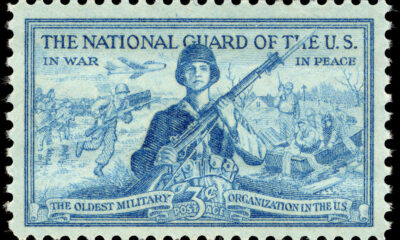Executive
A Military Necessity: Clear Thinking and Terminology
Military terminology must be exact, or defeat will result. The terminology of the U.S. Air and Space Forces doesn’t meet that standard.

Military history offers no shortage of examples in which imprecise thinking and terminology contributed to failure at some level; as well cases of clear and concise thought and language employed by leaders that contributed to military success. During World War II, U.S. Army chief of staff General George C. Marshall insisted upon clarity and brevity in all military orders and official communications. Anything less risked confusion, an improper understanding of the commander’s intent, and wasted precious time.
Marshall was not alone. The British Army’s Bernard Montgomery decried terminology he deemed unhelpful, or worse, defeatist. As his biographer Nigel Hamilton wrote, when in 1941 “Monty” was responsible for defending 215 miles of English beaches against a possible German invasion, Montgomery forbade the use of the previously employed terms, “Beach Battalion” and “beach defense.” The future field marshal was offensive-minded, and he realized that both terms conveyed a “defensive beach-bound mentality,” if not a defeatist one.
“Aerospace” or “Air and Space”
The history of the relatively new domain of space bears the same lesson. In 1957, U.S. Air Force chief of staff General Thomas White stated, “I want to stress that there is no division, per se, between air and space. Air and space are an indivisible field of operations.” Until 2001, that was the Air Force’s basic position. While it probably represented the thinking of most air leaders at the time, it also justified the Air Force’s acquisition and management of the vast majority of funding intended for both air force and space functions. Famously over the years, the service helped itself to dollars that Congress intended for space in order to beef up its own needy air programs. In the 1990s, the F-22 fighter program was one example.
In October 2001 the new Air Force chief of staff announced, as air-space scholar Benjamin Lambeth wrote, “a substantially changed direction in the Air Force’s approach” to the relationship between air and space. General John Jumper – whose first official staff meeting as the chief was on September 11 – said, “When I talk about space . . . I don’t talk about aerospace, I talk about air and space.” Jumper’s view was not a new perspective for him, but it matched nicely that of a recent congressionally-mandated space commission. The chief of staff added,
To me, space . . . is a separate culture. The physics that apply to orbital dynamics are different than what airmen experience in the air. And, there’s a culture that has to grow up that shows the same expertise in space as airmen showed after World War II in aerial combat. We have to respect that, and we have to grow and nurture that culture until it matures.
The distinction between aerospace and air and space was critical. If the former term expressed the physical reality, then, logically, the Air Force ought to control air-space forces, at least other than those specifically in support of land or maritime operations. But if the latter was more accurate, that argued for a separate service devoted to each domain.
Jumper’s statement and its implications probably escaped many non-space military observers, especially as he spoke not long after 9/11. This change to air and space played its part along the admittedly long and bumpy road leading to establishment of the U.S. Space Force. In 2018-2019, the stars aligned; the unexpected happened. The stunning establishment of the Pentagon’s sixth armed service was a team effort among numerous players, including defense department space professionals, a bipartisan Congress, a mercurial President Trump, and a revived National Space Council (chaired by Vice President Pence) following a quarter-century of dormancy.
Today’s challenge
Contrast the above with today’s military employment of the imprecise – arguably, useless – terms, diversity and equity. After several years of hearing these magical words bandied incessantly in the name of so-called social justice, Pentagon, armed service, and military school leaders still struggle to define them. As U.S. Supreme Court Justice Clarence Thomas opined, diversity “seems to mean everything for everyone.” Equity fares worse, running the gamut from equality of opportunity (already achieved in most cases) to sameness of outcome (utterly unachievable and undesirable) depending on the circumstances.
One thing is clear: military merit has been supplanted by contrived categories for cultural approval and political gain, in support of an ideology that seeks to replace precious traditions and institutions from the rule of law to the nuclear family.
Eighty years ago, Bernard Montgomery declared, “There is a great need today for clear thinking.” His laser-focused thinking, and – to some – his near-fanatical training regimen and personal discipline reformed the British Army, turning it into a modern army capable of taking on the Germans in North Africa and beyond. Today, who will restore our military’s clear, concise thinking and language – and its priorities – before suffering the likely result of their dearth on the battlefield?
This article was originally published by RealClearDefense and made available via RealClearWire.
Forrest L. Marion, Ph.D., is a retired U.S. Air Force Reserve officer and military historian. He is the author of Flight Risk: The Coalition’s Air Advisory Mission in Afghanistan, 2005-2015 (Naval Institute Press, 2018), and Standing Up Space Force: The Road to the Nation’s Sixth Armed Service (Naval Institute Press, Dec. 2023).
-

 Executive4 days ago
Executive4 days agoSecret Service chief gets no solace
-

 Executive3 days ago
Executive3 days agoWaste of the Day: Louisville Taxpayers Pay Nearly $600,000 For Empty Building’s Maintenance, Security
-

 Guest Columns4 days ago
Guest Columns4 days agoFear Itself: Democrats’ Favorite Strategy Caused Their Current Chaos
-

 Executive3 days ago
Executive3 days agoWhere is Joe Biden – or Jill?
-

 Executive1 day ago
Executive1 day agoWaste of the Day: Throwback Thursday: Cities Used Crime Prevention Funds on Soccer Games, Paper Shredding
-

 Executive2 days ago
Executive2 days agoFacile and politically motivated suggestions
-

 Civilization4 days ago
Civilization4 days agoBuild Iron Dome in the United States To Prepare for Israel’s Worst Day
-

 Executive4 days ago
Executive4 days agoThe Emerging GOP Plan To Beat Kamala Harris













